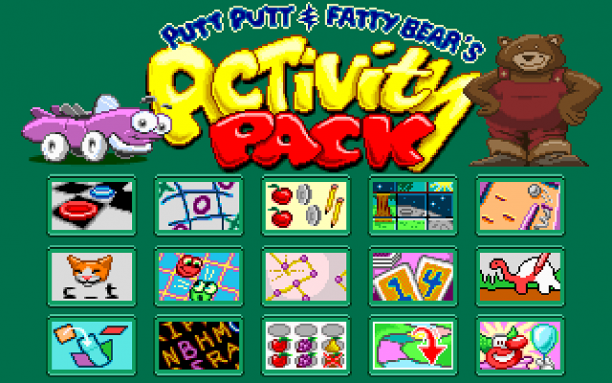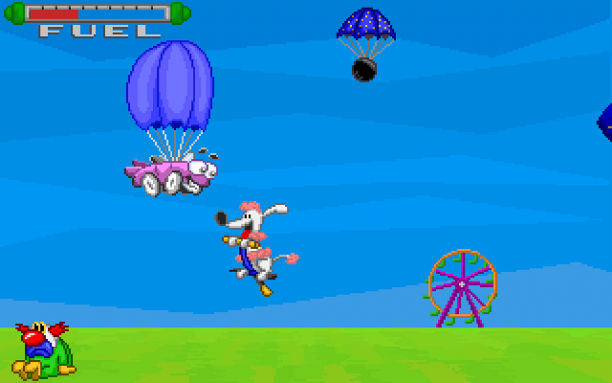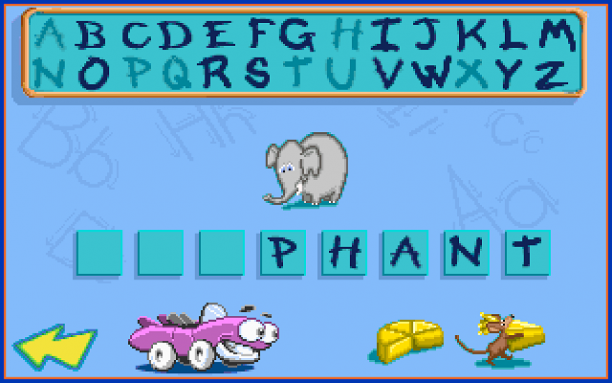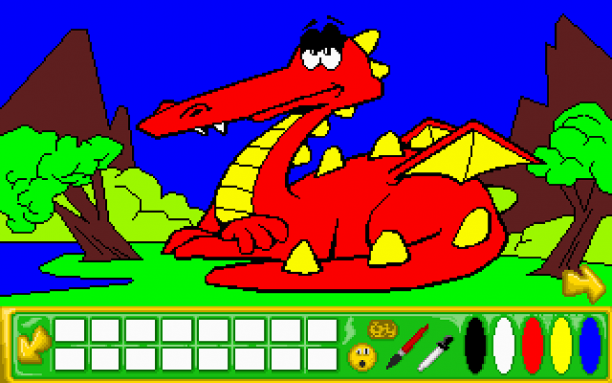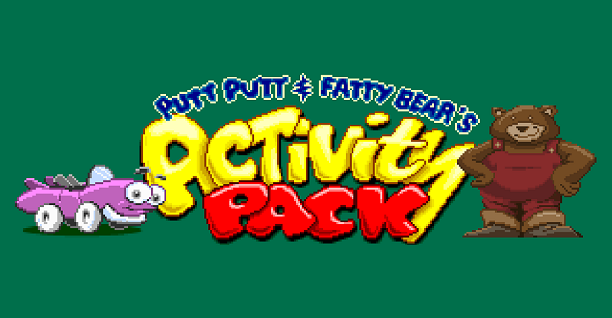
Pixel Gallery
Putt-Putt and Fatty Bear’s Activity Pack
Retro Platforms: Mac, PC
Platform Reviewed: PC
Humongous Entertainment is arguably one of the strongest developers when it comes to edutainment, having many popular gaming franchises that typically involve the adventure genre, all while also teaching themes with stories that can even appeal to some older audiences too. Pajama Sam’s first gaming entry presented a dream-like story that culminated in conquering one’s fears about darkness, Spy Fox had tension with trying to solve detective-like mysteries, Freddi Fish was a mystery series that explored aquatic settings, and Fatty Bear… well, actually, that series never really took off. One series that I used to play a lot was Putt-Putt, which involved the zany adventures of an anthropomorphic car and his overly energetic puppy: these journeys included setting up a parade, getting launched to the moon, saving animals at a zoo, and even joining a race! But I wanted to play something that was new to me, so for today’s review, I’m analyzing Putt-Putt and Fatty Bear’s Activity Pack.
Graphics
Being one of the earliest games released by the company, the titular car and bear have slightly less fluid drawings than their later adventures: the characters aren’t smooth in some areas, and their facial expressions can look a bit uncanny at times. The in-game objects, however, animate pretty well, partly due to the game’s high and stable frame rate. Fatty Bear generally looks more curved in his appearance, and his expressions appear more natural and less exaggerated; this is in contrast with Putt-Putt, whose constant grin and bizarrely floating eyebrows tend to feel creepily forced. In terms of their communications, both characters are really friendly, and some physical movements are also shown: the characters follow your mouse if you hover it around their heads, Fatty Bear telekinetically places objects by pointing at them, and Putt-Putt uses a very stretchy and flexible antenna to interact with things… I don’t exactly know how this works, but hey, it certainly looks cool.
Disappointingly, most of the visuals have very little to do with either of the mascots’ worlds, making Putt-Putt and Fatty Bear’s Activity Pack feel like a random mini-game pack that just happens to include the two talking anomalies; this isn’t an adventure-themed game, so it isn’t too unexpected, but there’s never really an imaginative world with significant notable depth. Despite this, many objects inside the mini-games have quirky personalities to them: a checker can grow legs and defeat enemy pieces, and pinballs can have faces and make maddening yelps, among other examples. There are lively things within the mini-games, and other drawings have vivid colors. Backgrounds are also present, but they’re usually very simple, and most of the settings are only slightly above primitive in nature. Within an options menu, there are also subtitles that can be added to accompany the characters’ voices, but the game seems to delay mouse movement until these disappear; there’s a numerical meter that slightly lowers this speed, but it’s unclear how to correlate this with an actual time.
Audio
The collection’s music is recycled from Putt-Putt Joins the Parade, with the few songs eternally rolling into one another. Tracks aren’t particularly complex in nature, especially since lots of the instrumental noises are played in short bursts, but the mood is kind of sweet; there’s a slight degree of musical layering too. At the end of the day, the soundtrack seems pleasant enough, but it’s also pretty forgettable. Something I do like is that the initial music and voice introductions change upon different start-ups of the collection, but there’s also something I dislike: it’s subtle, but there’s a persistent static-like noise in the background, which upon closer inspection might be a weak attempt at a tambourine. Like the options for subtitle speed, there are also menu sliders for music and sound effects; the latter slider further divides into gameplay sounds and voice clips.
Regarding sound effects, there’s a welcome amount of variety within the mini-games: sentient objects make wacky laughs, victories are usually accompanied with upbeat horns, basic moves provide audio feedback, and both mascots have many things to say. Both Putt-Putt and Fatty Bear are aware of the rules of the games that they run, so they have unique things to say for any kind of situation. In checkers, for instance, Putt-Putt will have multiple thinking sounds, let you know when he wins, and give different messages for losing via a lack of moves versus losing via a lack of pieces; almost every single mini-game is filled with various types of vocal feedback. The mascots are very enthusiastic too, and they’ll always remain friendly even when they win. That said, there are a few technical oddities: some spoken sentences are composed of multiple sound clips, and the last several games have significantly lower voice qualities that awkwardly stand out.
Gameplay
Putt-Putt and Fatty Bear’s Activity Pack contains not one, not two, but fifteen entire games to interact with… well, sort of. Some of these activities involve individually completing some kind of objective, like making guesses on a pattern by studying previous incorrect answers, or flipping tiles in a board to find certain pictures. Other mini-games are competitive in nature, being based on preexisting board or card games as the player and a mascot face off against one another; sadly, there are no second human player options. And then a few entries are basically just weird gizmos, such as coloring a picture, or messing around with the world’s most unrealistic pinball mechanics. Most of the activity pack’s games have four different difficulty levels, with easy seeming extremely approachable to most children, and hardest still being simple but requiring a decent amount of thinking. And because I’m likely not the target age demographic, I’ll be analyzing each of these games on their hardest levels, briefly describing the gameplay while also mentioning overall pros and cons.
Checkers
This activity pits you against Putt-Putt in a classic game of checkers, with you moving your pieces via the mouse, and him moving his pieces via telekinesis. For unexplained reasons, the literal pieces have it out for one another, speaking high-pitched war garbles while moving, and giving witty retorts such as “Bye-bye!” when they jump over other pieces. Putt-Putt makes the rounds feel livelier too, as he’ll sometimes express pondering. Regarding challenge, the car sometimes tries some interesting strategies like keeping pieces together or waiting to advance his front, but he also unfortunately seems to be way too generous when you make a mistake: there were several times when I tried giving him free pieces without consequence, but he ignored taking them a lot.
Tic-Tac-Toe
By the extremely limited nature of Tic-Tac-Toe’s design, the rounds inherently end really quickly, and even kids could probably figure out how to force every game into at least a tie within a few rounds. On the hardest mode though, I got surprisingly invested in trying to figure out how to beat Putt-Putt, as either contestant just going straight for the center will always result in you getting a tie at best; he’s also smart enough to never purposely let you get three spaces in a row. It turns out that this is actually a game of psychology, as both participants need to go for pieces on the side while hoping that the other doesn’t grab the center: more uncertainty is built through this strategy, and you essentially have to unknowingly trick the computer. The deceptive complexity is further assisted by the board drawings, which have shadows and slight tilt effects.
Remember
This is a memory matching game, and it’s one that starts out with unappealingly slow pacing before gradually picking up in intensity. You have thirty-two tiles to work with, but there are never more than two of any object, which will inevitably lead to a large number of random guesses before you’re able to start applying actual skill. When you eventually do see enough pieces, accompanied by sassy remarks from Putt-Putt, the game starts getting more fun and satisfying as you take away from the number of remaining pairs; there’s also a unique victory message if you never see the same card more than twice, which provides an impressive challenge for the player to overcome. However, I really feel like this game would benefit from having multiple pairs of the same object; otherwise, there’s simply too much trial and error initially involved.
Puzzle Blocks
Although the drawings have charming details, as well as vivid locations like carnival festivities, I find the actual gameplay quickly loses its appeal. You have to flip around three-by-three tile sets until you make a complete picture, but it’s not very engaging, and the victory noise that plays isn’t enough to make up for the notable lack of depth. The tiles don’t even reshuffle upon finishing one picture, nor is there any timer of sorts. What this game really needs is either a timer mechanic, or an objective-based hint of which picture you’re supposed to match as opposed to any; this would add some appreciated complexity and keep the player more actively engaged.
Pinball
This has very little to do with actual pinball, and the activity is basically a wide gizmo to mess around with. You select where to place tiles on a pachinko table, and then decide the tilt of the tiles; tilting’s only limited to three directions though, and the balls are inconsistent with how much they bounce around. There’s not much horizontal momentum either, as bounces never happen in more than one or two spaces in either direction; the balls pass through each other too. That said, messing around with the table is pretty amusing, and it helps that you can launch a very large number of simultaneous balls; said balls also have wacky personalities and never seem to stop making witty sounds, even if they get stuck in endless bouncing loops.
Cheese King
This game takes the familiar concept of Hangman, but shows a picture instead of providing a category. The presentation is also amusing, with incorrect guesses being followed by a mouse stealing wedges from your cheese; this design creates a slight tension, and Putt-Putt verbally escalates the drama once you’re on your last guess. Although it’s easy to me, I can see kids who are still learning words enjoying Cheese King. I do have a minor complaint with regards to ambiguity though: some occasional pictures have two reasonable answers, but only one of which is actually correct, such as a picture of pants actually meaning to represent jeans.
Reversi
This is like the board game Othello, and it’s actually pretty fun to play! Conditions like being unable to move and having to pass your turn are handled, and you’re encouraged to think multiple moves in advance: you could grab some enemy pieces in one move, or try to riskily prepare for a larger take-down that requires multiple successful moves. And what actually surprised me is that Fatty Bear, this game’s talking opponent, is actually surprisingly good at this! He doesn’t miss easy opportunities to grab lots of points, and I only managed to win my first game by getting a lucky layout at the very end. The board pieces are animated, the mouse movement is precise, and the game’s generally entertaining while keeping you thinking between individual decisions.
Lines and Boxes
Lines and Boxes is based on a popular square-acquiring game: on graph paper-like layout, and players alternate between claiming a line that corresponds to a fourth of a square, and if a newly placed line happens to complete a square, then the line-placer gets a point and moves again. Although the game has an extremely slow and rather boring start, it very gradually starts encouraging more complex thinking; consequences to not paying attention might include losing an entire chain of boxes. Other times, you may want to intentionally give your opponent several boxes since it’ll force them into making a move that could give you an even larger chain. Fatty Bear takes boxes when you basically give them to him, and the gameplay starts getting intense once this reverses.
Go Fish
This is based off the popular card game, and you’re able to actively switch between the cards representing pictures, numbers, or actual playing cards. In this version though, there’s a notable issue with the start-up time being really terrible: you have to painfully wait for cards to be assigned to each player one at a time, and there’s no way to skip this process. Once the game finally starts, it’s actually pretty fun, as the design mandates a combination of memory and choosing which information to reveal; asking for a certain card without Fatty Bear having that card basically reveals a type of card that he might ask for later down the line.
Coloring
There are thirty-five pictures available, and you’re naturally encouraged to color in predetermined areas with different colors. You initially have primary colors, but can combine different colors (and even colors that were already made with other colors) to create a much larger selection; this encourages experimentation and rewards curious players with more features. For my first vivid drawing, I gave life to a dragon who stood among a natural lake, and the color mixing ensured that my own dragon would be like no other. Incredibly exaggerated enthusiasm aside though, I do have some small complaints: some sections are hard to erase when their areas are skinny, and grabbing a color from the paintings feels a bit clunky.
Tangrams
This game involves having a bunch of uniquely sized shapes: rotate and move them into an overall outline in such a way that no space is unused. I’m actually kind of surprised at how deceptive the difficulty is, as it’s not as simple as just rotating some shapes into the correct areas. There may be multiple ways to fill an outlined square, but there are only a few ways to do it in a way that won’t cause later problems. Tangrams actually makes you think some, more than most of the other games in the collection. However, I do have a nitpick with the movement controls: you can’t freely move around the pieces so much as you snap them around by fixed distances… it’s hard to describe, but dragging shapes feels a little unnatural when you’re outside the outlined area.
Word Hunt
Word Hunt is literally a word search, and there’s really not much to say. Whenever I try to solve word searches, I usually look for generally large words in the actual board rather than individually track down words from a list. Honestly, I don’t find these very fun, as there’s not any challenge so much as there’s just tediousness in searching every direction on the board. The voice quality also starts to suffer in these last few games: it’s actually pretty bad in terms of technical quality. Regarding gameplay, I find Word Hunt to be unexciting, but that’s just me.
Guess It
Putt-Putt randomly swings around five fruit tiles, and then you have to guess what the fruits are once the tiles stop showing anything; however, the correct answer is actually randomized, so the fruit-spinning feels like a pointless visual gimmick. The gameplay itself has an interesting premise: if you answer incorrectly, then the zany car marks which ones are right, and you’re shown all of your previous guesses. If no fruits ever repeated more than once, then there would be some strategy in trying to study multiple previous failures to improve your probabilities on remaining guesses; sadly, this isn’t the case, so the gameplay literally amounts to nothing more than trial and error. It teaches kids to learn from mistakes, which is a good lesson in life, but it also feels way too luck-based; besides being boring, Guess It also ends up feeling unfair.
On Ramps and Off Ramps
This is based off Chutes and Ladders, which is a game that’s entirely based on luck. I find its overall design to be absurd, and you could basically get the same outcome by flipping a coin. Perhaps nearing the end of a map might feel slightly intense, and maybe counting the spaces to move ahead might serve as useful counting practice for kids, but I’ll never understand the appeal to these kinds of games.
Circus Storming
Circus Storming seems like something that could have been released on its own disc, as it’s actually a lengthy arcade game that spans more than fifty whole levels in total length! Difficulties determine which level you start on, and there’s a lives system in place. By the powers of fictional science, propellers help Putt-Putt navigate around mischievous obstacles (like anvils that somehow stay afloat due to single balloons), and you control his flight direction via vertical mouse movements. Some obstacles lower an already-declining fuel meter, and others cause an immediate crash. To counter the declining fuel, you can collect balloons, and a scoring system is based on remaining fuel at the ends of levels. Despite the primitive visual style, Circus Storming is one of the more entertaining games in the collection, but it’s not exactly designed for long-term play either.
Conclusion
Not every activity in this collection is a winner: a few games rely on a combination of luck and mindless waiting before they start getting more complex, and many of them have limited appeal. However, several of the activities encourage creative thinking, and these manage to train certain skills while also being generally fun; the silly gizmo activities are also short yet upbeat distractions. The competitive games are particularly enjoyable, and it helps that the opponents for these are competent on the highest difficulty. Technically, the presentation feels somewhat lacking, but there are also lots of voiced phrases for various situations, as well as random object sentience which adds charm. If you’re trying to get a young kid into video games, then I feel like this would be an ideal collection to buy for cheap. But for me? I’m likely not playing this again in the near future, but it seems decently designed for an edutainment game, and I can definitely see the specific appeal in a collection like this.
